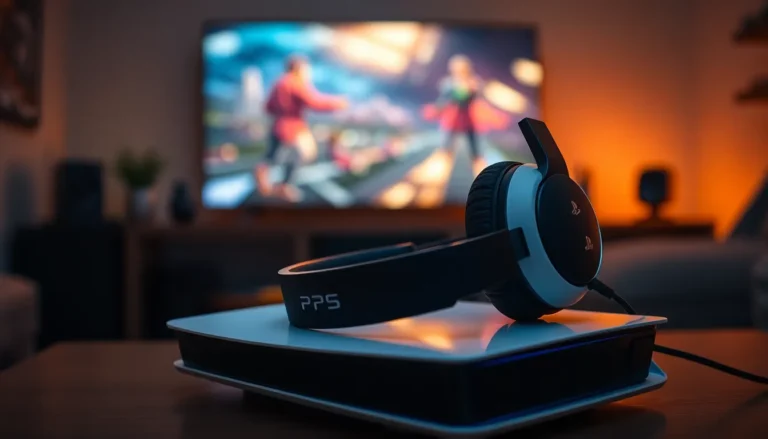Table of Contents
ToggleIn a world where staying connected is as vital as breathing, it’s hard to imagine life without Wi-Fi and Bluetooth. These invisible heroes make streaming cat videos and wirelessly connecting gadgets possible. But who’s the genius behind these technological marvels?
Meet the unsung inventors whose brainwaves sparked a revolution. From the early days of radio waves to the modern age of seamless connectivity, the story of Wi-Fi and Bluetooth is packed with innovation, creativity, and maybe a few late-night coding sessions fueled by coffee. Buckle up as we dive into the fascinating journey of how these two technologies came to life, and discover the masterminds who turned our lives into a wireless wonderland.
Overview of Wireless Technologies
Wireless technologies, such as Wi-Fi and Bluetooth, revolutionize how devices communicate. Wi-Fi enables high-speed internet access, allowing devices to connect to the internet without physical cables. Typically, Wi-Fi operates on 2.4 GHz or 5 GHz frequency bands, supporting multiple devices at once.
Bluetooth facilitates short-range communication between devices. It primarily uses the 2.4 GHz frequency band and excels in connecting peripherals like headphones and keyboards. Bluetooth technology supports connections within a limited range, usually around 30 feet.
Security features in wireless technologies are crucial. Wi-Fi employs protocols like WPA3, providing robust encryption to protect user data. Bluetooth incorporates security measures such as pairing codes and encryption, ensuring safe connections between devices.
Efficiency matters in the performance of these technologies. Wi-Fi offers varying standards, such as Wi-Fi 5 and Wi-Fi 6, each improving speed and connectivity. Bluetooth version developments, like Bluetooth 5.0, enhance data transfer speeds and extend range.
Applications for wireless technologies are vast. Wi-Fi connects home networks, enabling seamless streaming and online gaming. Bluetooth integrates into everyday devices, facilitating convenient hands-free calling and wireless audio streaming.
The impact of these technologies on daily life is significant. Wireless communications streamline tasks and enhance user experiences. Continuous advancements ensure that both Wi-Fi and Bluetooth remain indispensable in modern homes and workplaces.
Who Invented WiFi?

Wi-Fi, a pivotal technology in modern connectivity, traces its roots to several key innovators. These figures laid the groundwork for wireless networking as people know it today.
Key Figures in WiFi Development
Dr. John O’Sullivan, an Australian engineer, made monumental contributions to Wi-Fi. He was part of a team at the Commonwealth Scientific and Industrial Research Organisation (CSIRO) in the 1990s, focusing on radio technology. Ray Kuo and the late Dr. Alan H. Cooper also played significant roles, helping develop the protocols that support Wi-Fi standards. Their collective efforts in creating a robust transmission protocol paved the way for the wireless revolution.
Timeline of WiFi Invention
The timeline of Wi-Fi invention highlights significant milestones. In 1985, the U.S. Federal Communications Commission released the 2.4 GHz band for unlicensed use, allowing wireless experimentation. The first version of the IEEE 802.11 standard emerged in 1997, establishing the foundation for Wi-Fi technology. By 1999, Wi-Fi became commercially viable with the introduction of 802.11b, achieving speeds up to 11 Mbps. Subsequent standards, including 802.11g in 2003 and 802.11n in 2009, further enhanced speed and connectivity, ushering in the era of ubiquitous wireless access.
Who Invented Bluetooth?
Bluetooth technology emerged from the innovative work of several key figures.
Key Contributors to Bluetooth Technology
Jaap Haartsen and his team at Ericsson played a pivotal role in its development during the 1990s. They aimed to create a wireless protocol for short-range connectivity. Haartsen’s contributions included the initial concept and specification of the Bluetooth standard. Furthermore, the technology’s name stems from Harald “Bluetooth” Gormsson, a Viking king known for uniting Denmark and Norway. This historical reference symbolizes the purpose of Bluetooth to unify devices wirelessly. Other contributors, like Sven Mattisson, also significantly advanced the specifications, ensuring interoperability between devices.
Evolution of Bluetooth Standards
Bluetooth standards have undergone significant changes since their inception in 1998. Version 1.0 allowed basic connectivity between devices but had limitations in speed and range. Significant improvements arrived with Bluetooth 2.0, which included Enhanced Data Rate, achieving speeds up to 3 Mbps. The introduction of Bluetooth 4.0 brought Low Energy technology, increasing battery efficiency for wearables and IoT devices. Bluetooth 5.0 further expanded the range up to 800 feet and doubled the data transmission speed. As of October 2023, Bluetooth 5.2 introduces features like multi-stream audio, enhancing the pairing experience for modern devices.
Comparison of WiFi and Bluetooth
Wi-Fi and Bluetooth serve distinct purposes in wireless communication. While Wi-Fi connects devices to the internet over longer distances, Bluetooth enables short-range communication between devices. Commonly, Wi-Fi operates on 2.4 GHz or 5 GHz bands, providing high-speed internet access. In contrast, Bluetooth operates primarily on the 2.4 GHz band, suitable for devices like headphones and keyboards within approximately 30 feet.
Speed differences are notable between the two. Wi-Fi typically offers higher data transfer rates, with Wi-Fi 6 providing speeds up to 9.6 Gbps. Bluetooth, particularly with advancements in Bluetooth 5.0, supports speeds of up to 2 Mbps, making it effective for lower-bandwidth applications.
Next, their connectivity range sets them apart. Wi-Fi can cover areas as expansive as several hundred feet, depending on router strength and interference. Bluetooth, however, maintains a limited range, offering reliable connections only within 30 feet. This short-range focus on Bluetooth emphasizes its function for personal devices and peripherals.
Security features also differ between Wi-Fi and Bluetooth. Wi-Fi utilizes protocols like WPA3 for robust encryption, ensuring secure internet connections. On the other hand, Bluetooth employs pairing codes and encryption measures to keep connected devices secure against unauthorized access.
Finally, applications demonstrate their complementary roles. Wi-Fi excels in home networking, allowing seamless streaming and gaming experiences. Meanwhile, Bluetooth dominates in connecting peripherals, simplifying hands-free calling and audio streaming. Both technologies remain essential in modern connectivity, enhancing daily life through their unique functionalities.
Impacts on Modern Connectivity
Wi-Fi and Bluetooth technologies significantly enhance connectivity in everyday life. Enhanced internet access through Wi-Fi enables multiple devices to connect seamlessly. Operating on 2.4 GHz and 5 GHz frequency bands, it revolutionizes settings from homes to offices by eliminating the need for physical cables.
Bluetooth plays a critical role in short-range communication, especially for personal devices. Effective within a range of about 30 feet, it connects peripherals like headphones and keyboards effortlessly. Innovations like Bluetooth 5.0 further improve functionality with expanded range and faster speeds.
Both technologies impact how users interact with their devices daily. Wi-Fi supports tasks such as streaming and online gaming, while Bluetooth simplifies hands-free calling and wireless audio streaming. Advancements in standards, such as Wi-Fi 6 and Bluetooth 5.2, continue to enhance user experiences.
Security measures in these technologies ensure safe connectivity. Wi-Fi employs protocols like WPA3 for encryption, safeguarding data transmission. Meanwhile, Bluetooth implements pairing codes and encryption methods to protect information in short-range interactions.
Moreover, these innovations foster new applications across various industries. Smart homes benefit from Wi-Fi for device integration, while Bluetooth enhances user convenience by connecting wearables. The adaptation of these technologies in modern lifestyles underscores their vital roles.
Device compatibility remains essential, as both Wi-Fi and Bluetooth provide solutions for seamless integration. Smart speakers, IoT devices, and other gadgets rely on these technologies for effective communication. As users continue to embrace advancements, the importance of both Wi-Fi and Bluetooth remains unequivocal in shaping future connectivity.
Wi-Fi and Bluetooth have transformed the way people connect and communicate. Their inventors laid the groundwork for technologies that have become integral to daily life. As these innovations continue to evolve, they enhance user experiences and ensure seamless connectivity across various devices.
The collaboration between these technologies allows for a more integrated and efficient digital environment. With ongoing advancements and improvements in security and performance, Wi-Fi and Bluetooth will remain essential in shaping the future of connectivity. As they adapt to the growing demands of modern users, their impact will only continue to expand.





